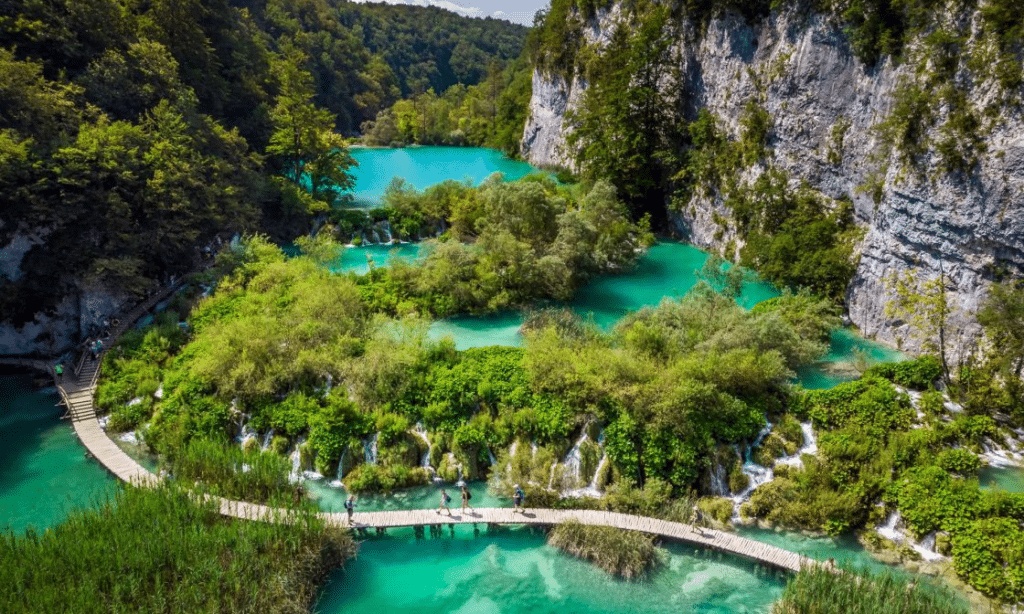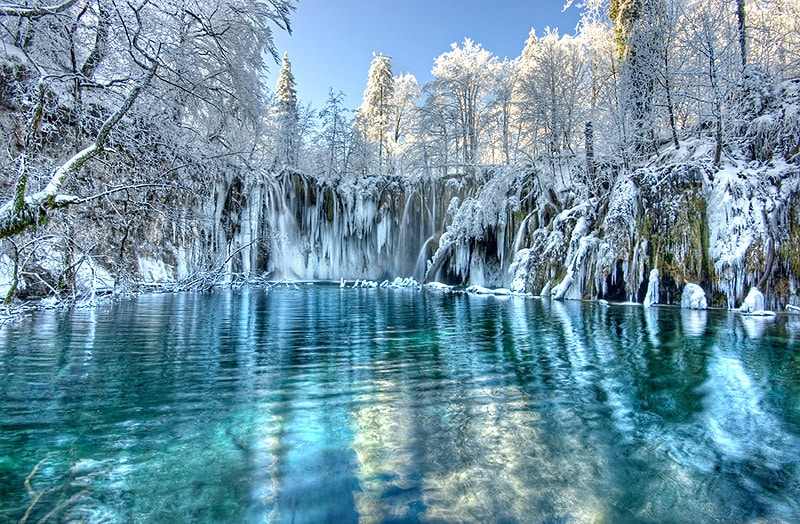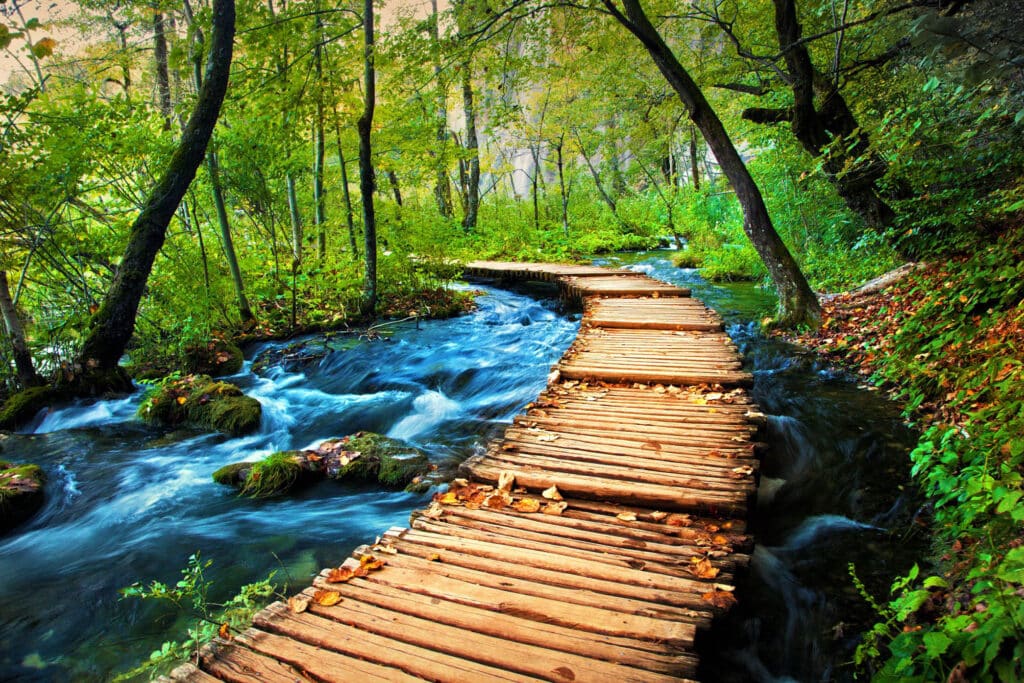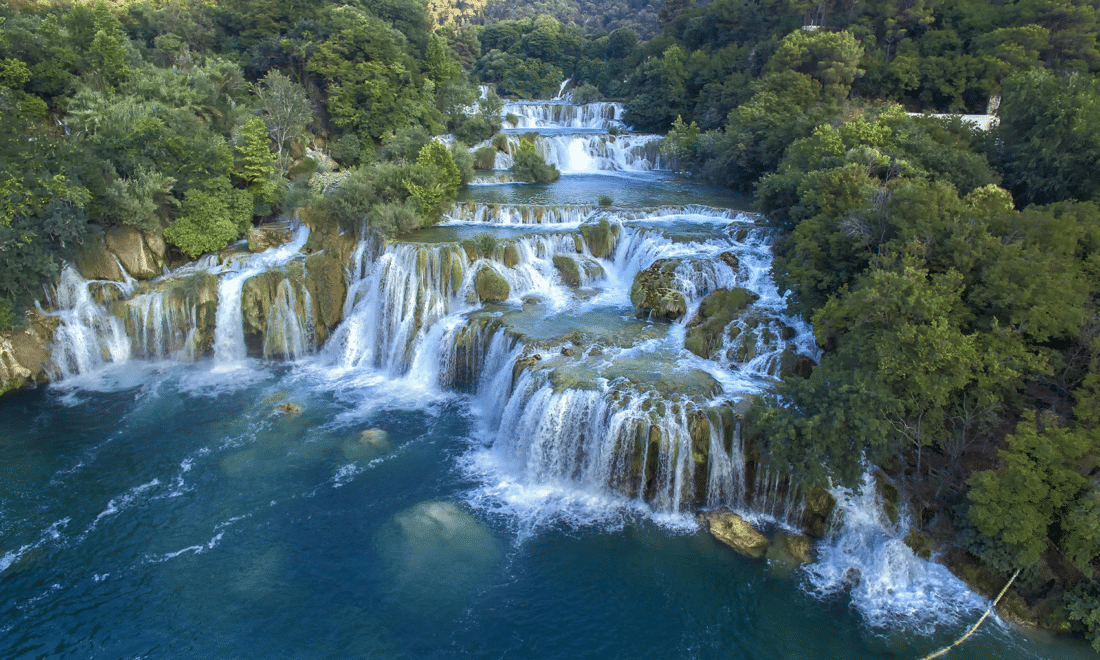In this Plitvice Guide (or Plitvice Lakes Guide), we will shortly introduce you to the most famous Croatian natural attraction, which has been attracting tourists from all over the globe for centuries. They are well-known for their beauty and peculiar waterfalls and lakes, making them unique. So, let’s find out more.

©2017 Mike Mareen/Shutterstock
Our website includes affiliate links. So, remember that we may receive commissions when you click our links and make purchases. Please read our legal disclaimer document for more information about our Affiliate disclaimer and other disclaimers like the Fair-Use disclaimer.
Introduction of this Plitvice Guide
Plitvice Lakes National Park is the oldest and largest national Park in Croatia. It became the first national Park of the Republic of Croatia in April 1949. The process of tufa formation, where tufa barriers and lakes are created, made it a UNESCO World Heritage Site on October 26, 1979. The Park encompasses 16 interconnected crystalline lakes and countless waterfalls. Its cascades continuously change due to the mineral-rich waters that carve through the rock. Wooden footbridges and pathways stretch for 11 miles (18 km) and offer an exceptional view of the Park’s stunning natural beauty.
It’s exquisitely scenic—so much so that 1979, Unesco proclaimed it a World Heritage Site. The name is slightly misleading, though, as the lakes are not the attractions here; hundreds of waterfalls link them.

©visit-croatia.hr
Exploring the Park
Entrance 2 is the southernmost entrance leading down to Kozjak Lake, the Park’s largest lake. It has a small island and a path along the lake’s eastern shore, leading to the lower lakes with forests, caves, cliffs, and waterfalls, or you can take a free boat. You’ll come across Milanovac, Gavanovac Lakes, and the open-topped cavern of Šupljara with a stunning viewpoint. A wooden walkway takes you across Kaluđerovac Lake and past two towering waterfalls. The second, Veliki Slap, is Croatia’s tallest waterfall, with a 255ft (78m) drop.
To explore the upper lakes, follow the trail from P1 to Gradinsko Lake, where you can see nesting wild ducks. From there, cascades lead to Galovac Lake, which has many ponds and falls. The stairs over the falls are covered by travertine, creating a stunning panorama. Smaller lakes are situated above Okrugljak Lake, supplied by two powerful waterfalls. Further up are Ciginovac Lake and Prošćansko Lake, surrounded by thick forests.
Depending on your fitness level and the duration of your trip, you have several options for exploring the area. You can travel by boat, road train (a tourist bus with carriages), or hike. Each ticket includes a helpful map, and the information booths are always ready to assist you.
Alternatively, you can start exploring the Park through Entrance 1, which many prefer because it is closer to all the most prominent attractions.
How you can visit it
If you plan to visit the Park, you can explore it by car and then go hiking or biking. However, we highly recommend you take a park excursion to experience the beauty of the Park. These excursions offer an opportunity to get up close with the Park’s sights, explore footpaths along the water, and learn from presentations, talks, and other exciting activities. To find the best tours, please click the link:
Pro Travel Tip: For the best experience, plan to stay overnight near the Park so you can start your day early. It’s worth it!
Tickets and other practicalities
Buy tickets online at least one day before you visit the Park. The Park’s natural beauty is worth exploring for a full day. Half-day and day trips from Zadar, Split, or Zagreb are possible. Expect to walk a fair distance.
The upper lake section takes 2 hours and the lower section 3 hours. Start with the bus ride and end with the boat ride. Swimming is not allowed in any of the lakes.
How to get there
Plitvice Lakes National Park lies on route D1 between Slunj and Korenica in Croatia, close to the border with Bosnia and Herzegovina. You can access it via the Karlovac exit in the north, the Otočac exit in the west, or the Gornja Ploča exit in the south. Several municipalities surround the Park, including Ogulin, Rakovica, Otočac, Gospić, and Bihać in Bosnia. The nearest airports are Zadar, Zagreb, and Rijeka, and visitors can reach the Park by taking direct bus lines from Zagreb, Karlovac, Zadar, or Split. The Park features beautiful karst poljes, such as the Gacko polje, and is located about 110 km (68 mi) from the coastal town of Senj by road.
When to visit
Although the Park is beautiful all year round, the best times to visit are spring and fall. During spring and early summer, the falls are abundant with water. At the same time, the changing leaves produce a colorful display in autumn. Winter is also spectacular, although access may be limited due to snow, and the free park transport service won’t operate. However, the admissions are much cheaper then. You should avoid the peak months of July and August as much as possible, as the falls reduce to a trickle, parking can be difficult, and the large number of visitors can turn the walking tracks into a conga line and cause lengthy waits for the buses and boats that transport people around the Park.
Where to stay?
The four hotels the National Park manages are conveniently located on the Park’s borders. Two campsites are also available. Please check out lodging possibilities near Entrance 1, Entrance 2, or Mukinje Plitvice.
But if you prefer a better lodging experience, excellent guesthouses are within walking distance of the surrounding villages. Alternatively, for a more atmospheric and unique experience, you can search for private rooms in the tiny and idyllic town of Korana, which is set by a gurgling stream. You can reach this town by a narrow road north of the Korana Bridge.
FAQs
How do you get from Split to Plitvice Lakes National Park?
Drive from Split to Plitvice Lakes National Park via the A1 toll highway. Take the Gornja Ploča exit and then follow the D1 Road to reach the Park. The journey takes 2-2.5 hours. Plitvice Lakes National Park is only 240 km away from Split. Book a tour from Split if you want to visit the Park.
What is the best way to visit Plitvice Lakes National Park?
“If you are planning a day trip to Plitvice Lakes, one of the best ways to do it is with a guide, which usually includes transportation. A pro travel tip would be to stay overnight near the Park to start your day early and get the most out of your experience. It’s worth it!”
Is entrance 1 or 2 better at Plitvice?
Entrance 1 is considered the most ideal entrance to Plitvice Lakes National Park. Opting for Entrance 1 allows you to witness the Park’s key attractions right from the start. As you stroll through, you’ll be greeted by a spectacular aerial view of Veliki Slap, Croatia’s tallest waterfall.
Do you need to book Plitvice Lakes in advance?
We recommend buying Plitvice Lakes tickets online and in advance to find deals and avoid sold-out tickets.
What is the best time of day to visit Plitvice Lakes?
The best times to visit Plitvice Lakes are in the morning (7 am – 10 am) or after 4 pm (closing time varies by season). Tour buses usually arrive between 11 am and 3 pm.
Can you swim there?
No, you can’t.
Take a look at
References and sources:
Photo credits:
Photo credits: visit-croatia.hr





